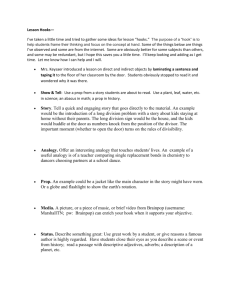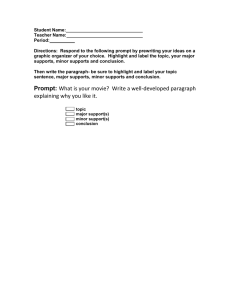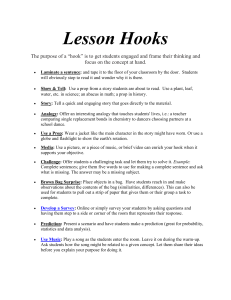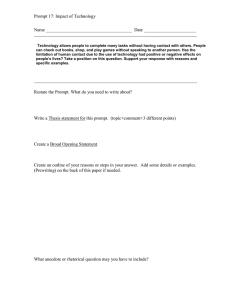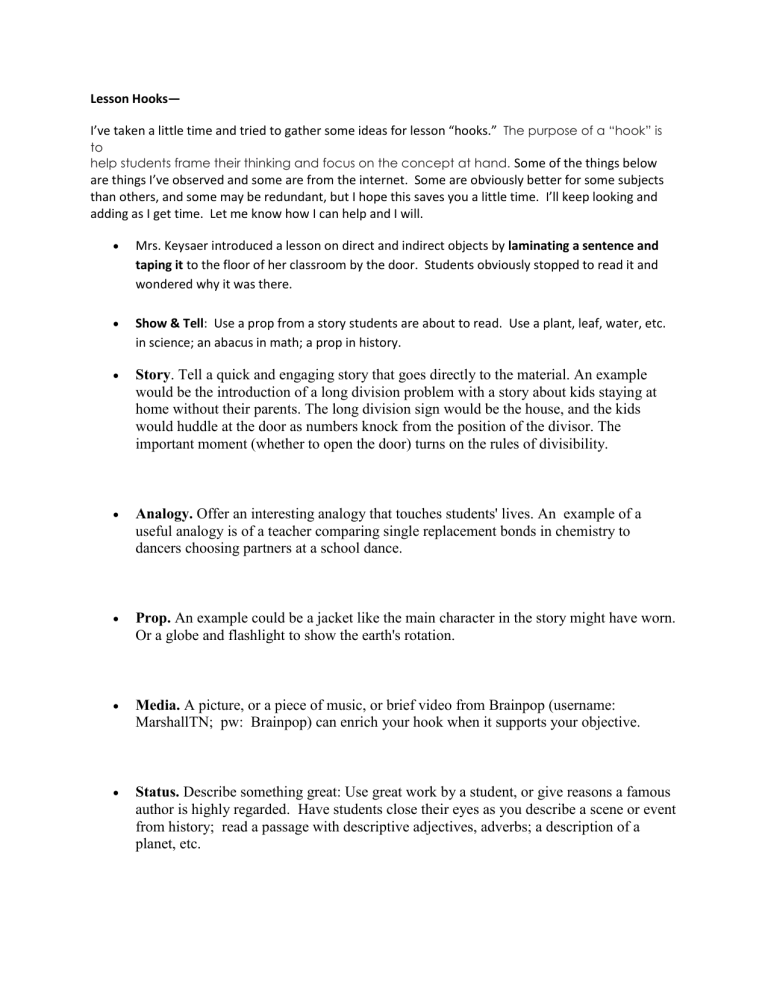
Lesson Hooks— I’ve taken a little time and tried to gather some ideas for lesson “hooks.” The purpose of a “hook” is to help students frame their thinking and focus on the concept at hand. Some of the things below are things I’ve observed and some are from the internet. Some are obviously better for some subjects than others, and some may be redundant, but I hope this saves you a little time. I’ll keep looking and adding as I get time. Let me know how I can help and I will. Mrs. Keysaer introduced a lesson on direct and indirect objects by laminating a sentence and taping it to the floor of her classroom by the door. Students obviously stopped to read it and wondered why it was there. Show & Tell: Use a prop from a story students are about to read. Use a plant, leaf, water, etc. in science; an abacus in math; a prop in history. Story. Tell a quick and engaging story that goes directly to the material. An example would be the introduction of a long division problem with a story about kids staying at home without their parents. The long division sign would be the house, and the kids would huddle at the door as numbers knock from the position of the divisor. The important moment (whether to open the door) turns on the rules of divisibility. Analogy. Offer an interesting analogy that touches students' lives. An example of a useful analogy is of a teacher comparing single replacement bonds in chemistry to dancers choosing partners at a school dance. Prop. An example could be a jacket like the main character in the story might have worn. Or a globe and flashlight to show the earth's rotation. Media. A picture, or a piece of music, or brief video from Brainpop (username: MarshallTN; pw: Brainpop) can enrich your hook when it supports your objective. Status. Describe something great: Use great work by a student, or give reasons a famous author is highly regarded. Have students close their eyes as you describe a scene or event from history; read a passage with descriptive adjectives, adverbs; a description of a planet, etc. Challenge. Offer students a very challenging task and let them try to solve it. An example would be when a teacher asked students what a complete sentence was. The teacher gave the students five words to use for making a complete sentence. The students couldn't make a sentence. So, the teacher asked the class what was missing? The answer was a missing subject. This surprise of the unsolvable riddle hooked the students for the remaining hour of the class. Place objects in a brown bag. Have students reach in and make observations about the contents of the bag (similarities, differences). This can also be used for students to pull out a strip of paper that gives them or their group a task to complete. Gallery Walk: Using images or objects, students move from station to station making observations. The goal is for students to come to a conclusion about the objects/images that is related to a particular concept. Survey: Survey your students by asking questions and having them step to a side or corner of the room that represents their response. Prediction: Present a scenario and have students make a prediction (great for probability, statistics and data analysis). Stumped: Create a scenario where someone is stumped and the students must figure out a solution independently or in groups. Song: Play a song as the students enter the room. Leave it on during the warmup. Ask students how the song might be related to a given concept. Let them share their ideas before you explain your purpose for doing it. Experiment: Conduct an experiment that illustrates a concept. For example, use water to fill 3D containers to illustrate volume or help students make a recipe using benchmark measurements. Vocabulary connections: Give students a group of words related to the lesson…have them guess the topic or find the word that doesn’t fit in the group. News: Bring in a newspaper article or online news clip that addresses an area of interest or importance to your students. Skit/Dress-Up: Give students roles and have them act out a skit. Or, you can come in dressed for a given role. It can be as simple has wearing a sports jersey if you’re writing algebraic equations on a person buying a $75 ticket and x number of hot dogs at a game. And some more… Show a movie or TV clip, read an excerpt from a book, writing prompt (“Tell me about a time when…”), Riddles, Brain Teasers, scavenger hunt Ask a Question Description: In order to get your students engaged in an upcoming lesson, ask them a question that will interest them and activate prior knowledge. Example: Ask students to recall their favorite movie or favorite story from earlier in the year. Ask students to recall who the story is mostly about and use this as an opening to introduce main character. Use a trade book Description: Using a picture book at the start of the lesson can be an effective strategy to motivate students and provoke interest. Math instruction, reading comprehension skills, writing traits, science and even social studies concepts can all be introduced using children’s literature. Picture books help make learning new concepts more accessible to students by highlighting the concepts in cultural context. Example: Determining cause and effect relationships can be a challenging skill for upper elementary students to learn. The Great Kapok Tree: A Tale of the Amazon Rain Forrest, by Lynne Cherry is a picture book that contains many high-interest examples of cause and effect relationships. Resources: http://math.asu.edu/~bethgn/bibliography.shortened.htm - this provides a comprehensive list to use with math concepts http://classroom.jc-schools.net/read/picture-books.pdf - this site provides some good ideas of books to use in order to introduce reading comprehension skills http://www.lookybook.com/ - membership is required, but this site gives you access to many books online Using Picture Books To Teach Writing With The Traits by Ruth Culham – This book provides an extensive list of books to use in order to teach the six traits Using Picture Books to Teach Language Arts Standards in Grades 3-5 Brenda S. Copeland, Patricia A. Messner http://www.lebanon.k12.mo.us/profdev/picturethis_20050406.pdf - this includes many ideas of books to use across content areas. Play a game Description: As noted above, the anticipatory set can be used to connect new learning to what students have learned already. Playing a quick game in order to recall prior knowledge can be an effective strategy for getting students engaged in the lesson and prepared to build off prior knowledge. Example: play a quick math facts game, such as ‘around the world’ prior to introducing multi-digit multiplication. Resources: http://beta.tfanet.org/wps/myportal/teachinglearningcenter/resourceexchange/res ourceprofile?resource_id=4ffa44dae06433a9:68cfb8e8:11dab19cec8:-7d4 – this is a dice game to reinforce number sense using decimals Tell a story Description: In order to highlight a concept, a teacher can choose to tell a story that is closely related to the concept. Example: For instance, in order to demonstrate the skill of sequencing, a teacher can give a humorous example of her day out of order, and ask students to reorder the story in the correct order. Use a visual Description: Teachers can use visual aides to encourage students to better connect to new concepts. Example: A teacher could tell students that they have thirty seconds to remember everything they can about a painting. After the thirty seconds, the teacher will remove the painting and ask students to recall all they can about the painting. The teacher will solicit ideas and use this to introduce distinguishing between main idea and supporting details. Use manipulatives or models Description: Teachers can use physical models to prepare students to learn a specific concept or better highlight the critical attributes of new concepts. Examples: In order to teach geometry, the teacher could use a variety of models of two or three-dimensional shapes. http://teachingasleadership.org/sites/default/files/How_To/PP/P3/p3_opening.pdf Writing Prompt Description: Ask students to write everything they know about an upcoming learning objective, or present them with a prompt that is closely related to the learning objective. Example: Prior to teaching student about area and perimeter, give them a writing prompt about remodeling their room including re-wallpapering a wall and replacing the trim around the carpet. Graphic Organizer Description: In order to prepare students for the lesson a teacher could ask student to use a graphic organizer to generate thoughts closely related to the learning objective. Examples: The teacher could ask students to generate statements that they are certain are true and those that they are not certain about, recording statements in a T-Cart, prior to engaging in a lesson on fact and opinion. Resource: http://teachingasleadership.org/sites/default/files/How_To/PP/P3/p3_opening.pdf Make a prediction Description: Students have real-life context around a variety of skills they are required to learn in the upper elementary grades. Tapping into their real-life knowledge and asking them to make predictions using what they know can be an effective strategy in order to build new knowledge. Example: Prior to teaching a lesson on measurement, have students make predictions about the size of objects that are familiar to them. Tell a joke Description: Using humor is a sure way to engage your students. Telling an initial joke & then probing students or explaining to students why the joke is humorous can be a fun way to introduce a lesson Example: To teach homonyms, tell the following joke (use a whisper for the pony’s voice): A pony walks into a restaurant and says to the waiter “excuse me sir, can I order a soda?” The waiter responds “excuse me, but I can’t hear you!” The pony then says “I’m sorry but I’m a little hoarse.” Resources: http://www.math.ualberta.ca/~runde/jokes.html - these are advanced for the upper elementary classroom, but may prompt your creative side or give you ideas on how to format jokes. Use a song or video clip Description: There are a wide variety of songs and video-clips available for use in the classroom. Using songs and clips can be a high-tech way of drawing your students into classroom content Resource: www.brainpop.com www.asset.asu.edu/ - this site is easy to search and offers a wide variety of videos www.thinkport.org/Classroom/onlineclips.tp http://hubblesource.stsci.edu/sources/video/clips/ (science) http://www.teachersdomain.org/ http://sciencehack.com/ (science) Brain-storm Description: Your students possess a great deal of contextual knowledge around a variety of topics and issues related to classroom content. Tapping into this prior to teaching a new concept may be an effective method for setting the stage for new learning. Example: Prior to introducing a science lesson on recycling, ask students to brainstorm a list of what happens to things that they don’t recycle. Give a scenario Description: In order to highlight the major learning of a particular lesson, give students a scenario which requires them to draw conclusions around the major learning objective. Example: Prior to teaching students to make inferences or draw conclusions, the teacher could present students with the following scenario: “ A man walks out of a bank wearing a black ski mask” The teacher would then prompt students to think through some possible conclusions. Present a challenge/riddle Description: Prior to introducing a new concept, give students a challenge or problem to solve. Using inquiry can engage students and motivate them to learn. Example: Prior to teaching multiplication give students a real-life example that would be time-consuming to solve using repeated addition. Act it out Description: ask your students to act out something in order to highlight a learning objective. Example: To teach students to classify living organisms as vertebrates or invertebrates, give several students an organism to act out. After the class guesses the organism write the name of the organism on the board, making sure to list vertebrates in one column and invertebrates in the other. Use this to prompt a discussion regarding the differences between the two groups. Scavenger Hunt Description: Present student with clues about the learning objective they will be taking on for the day. Example: In order to teach students to measure with appropriate units,
